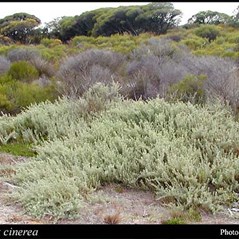Uses: For exposed coastal locations. As soil and sand control on roadsides, verges, fire breaks, parks and reserves.
If planted along roadsides reflected silver foliage increases visibility.
Attracts native butterflies, caterpillar food plant.
Note: This species is provisionally classified schedule 1, Regulation 24.2 under the Sewerage Act. Written approval is required prior to planting in streets or roads.
It should not be planted closer than two metres to any sewer main or connection.
Note: Fire retardant plant as per SA Country Fire Service, contact for further information.
This plant is indigenous to the following botanical regions of South Australia.
:NU: Nullarbor
:GT: Gairdner-Torrens
:EP: Eyre Peninsula
:YP: Yorke Peninsula
:SL: Southern Lofty
:KI: Kangaroo Island
:SE: South Eastern
For detail on these regions refer to the user guide.
- Height 1-2m
- Spread 2-3m
- Position
- Part Shade
- Full Sun
- Family Chenopodiaceace
- Botanical Name Atriplex cinerea
- Common Name Coast Saltbush
- Origin SA
- Habit Dense, Spreading
- Landscape Coast, Coastal cliffs, Coastal footslopes, 2nd line coast, Plains
- Soil Texture Loam, Sand
- pH Alkaline, Neutral
- Tolerates Drought, Fire, Soil salinity, Salt spray
- Supplementary Watering None
- Flower Colour Cream
- Flowering Time Spring, Autumn
- Foliage Grey
- Flower Type Clusters
- Purpose Ornamental, Erosion, Habitat
- Evergreen/Deciduous Evergreen
- Form Medium Shrub (Usually between 1.2m & 3.6m)
- Indigenous to the Adelaide Region







